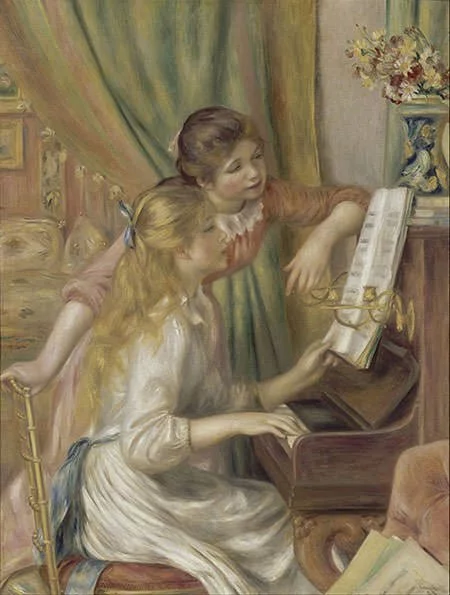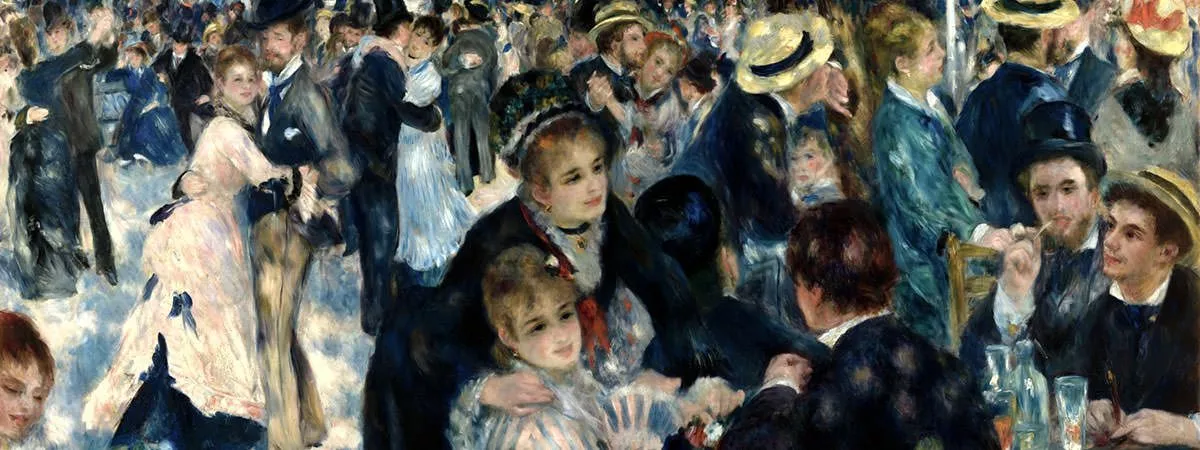Active during the second half of 19th century and early 20th century, Pierre-Auguste Renoir (February 25, 1841 – December 3, 1919) was a prolific French artist who was a pioneer as well as a leading painter of the art movement Impressionism. Along with Claude Monet, he developed several artistic techniques which became associated with the movement including the practice of painting outdoors; sketch-like technique of using broad, loose brushstrokes; and use of bright color to represent light and atmospheric effects. While his earlier artworks exhibit Impressionist qualities, he later distanced himself from the movement and drew inspiration from classical art. He is most known for his depictions of women, evolving Parisian society and domestic scenes; as well as nudes and dance paintings. Know more about Renoir’s art through his 10 most famous paintings including Impressionist masterpieces like Luncheon of the Boating Party and Bal du moulin de la Galette.
#10 The Swing

| Location: | Musée d’Orsay, Paris, France |
| French Title: | La Balancoire |
| Year: | 1876 |
This painting was created by Renoir the same year he created his most famous masterpiece Dance at Le Moulin de la Galette. Renoir was living on rent in a cottage at Musée de Montmartre gardens so he could be close to Moulin de la Galette, an open-air dance-hall and café. While there, he worked on The Swing during the mornings. The painting depicts a woman on a swing talking to a man while a little girl and another man watches them. The model in focus is the French actress Jeanne Samary, who appeared in several other paintings by Renoir including Luncheon of the Boating Party. The two men in the picture are Renoir’s brother Edmond and a painter friend named Norbert Goeneutte. The Swing was created in the Impressionist style and was exhibited at the Third Impressionist Exhibition of 1877.
#9 Young Girls at the Piano

| Location: | Musée d’Orsay, Paris, France |
| French Title: | Jeunes Filles Au Piano |
| Year: | 1892 |
Domestic scenes featured regularly in Renoir’s later works and young women playing the piano was a recurring and favorite subject for him. Renoir was invited by the French government to execute a painting for the Musée du Luxembourg and this masterpiece was the result of this commission. Renoir took extreme care for the project developing and refining the composition in a series of five canvases. The other variations of the painting may be seen at Metropolitan Museum of Art in New York and the Musée de l’Orangerie in Paris. Young Girls at the Piano, in which Renoir masterfully depicts an intimate and engaging scene in a middle class household, is considered the most successful in his series of artworks on domestic life.
#8 La Loge

| Location: | The Courtauld Gallery, London, UK |
| English Title: | The Theater Box |
| Year: | 1874 |
Scenes from the modern life was one of the favorite subject of the Impressionists. Renoir’s La Loge demonstrates this interest in modern leisure. It depicts a fashionable couple seated in the best seats at the theater. Like many Impressionists, Renoir uses the theater to capture the changing nature of fashionable Parisian society but he also adds mystery through his narrative. The elegantly dressed woman has lowered her opera glasses possibly to reveal herself to admirers in the theater while her companion raises his binoculars presumably to get a closer look at a beautiful woman. The woman depicted is Parisian model Nini Lopez while her male companion is Renoir’s brother Edmond. La Loge was the principal contribution made by Renoir to the very first Impressionist exhibition in 1874.
#7 The Umbrellas

| Location: | National Gallery, London, UK |
| French Title: | Les Parapluies |
| Year: | 1881 |
This painting depicts a busy street scene in Paris with most people using umbrellas to guard themselves against the rain. The Umbrellas is famous as it shows two phases of Renoir’s artistic career. It was painted in two parts. Renoir began to work on it around 1881 using the fast brushwork and vibrant shades of Impressionism. He returned to the painting in 1885 when he had lost interest in Impressionism and drew inspiration from classical art. The left side of the painting, particularly the principal female figure, has been painted in a more classical linear style with use of more muted colors. The Umbrellas exemplifies Renoir’s important contribution of introducing underlying structure into the Impressionist mode of vision. This set the stage for early Post-Impressionist artists like Paul Cezanne.
#6 Two Sisters (On the Terrace)

| Location: | Art Institute of Chicago, USA |
| French Title: | Les Deux Soeurs (Sur la Terrasse) |
| Year: | 1881 |
Maison Fournaise (House of Fournaise) is a restaurant located on an island in the Seine in Chatou, west of Paris. It serves as the location of not only this panting but another masterpiece by Renoir titled Luncheon of the Boating Party. The elder sister in the painting is Jeanne Darlot, who went on to become an actress. The identity of the younger sister remains unknown through it is stated that she is not related to Jeanne. The title Two Sisters was given to the painting by Renoir while the title On the Terrace was given by its first owner Paul Durand-Ruel. In 1925, American art collector Annie Swan Coburn bought the painting for $100,000. In 1932, it was bequeathed to the Art Institute of Chicago. Since then it remains one of the most popular paintings at the museum.
#5 La Grenouillere

| Location: | Nationalmuseum, Stockholm, Sweden |
| English Title: | The Frog Pond |
| Year: | 1869 |
It was the summer in 1869 when Renoir, along with Claude Monet, began sketching beside the water at La Grenouillère, a boating and bathing resort on the Seine River, outside Paris. This was a watershed moment in art history as the two developed several of the theories, techniques and practices that would give rise to Impressionism. Both the artists painted their versions of the resort from the exact view point. Monet’s version is known as Bain à la Grenouillère (Bath at la Grenouillere). Both painters have used rapid, unmasked brushstrokes in their versions, a technique now described by scholars as initiating “the pictorial language of classic Impressionism.” However, while Monet focuses more on the effects of light on the scene, Renoir’s version gives a more clearer view of the human subjects which may be seen in the elaborate hairstyles of the ladies.
#4 Dance at Bougival

| Location: | Museum of Fine Arts, Boston, Massachusetts, USA |
| French Title: | Bal à Bougival |
| Year: | 1883 |
An interviewer once wrote about Renoir: “He loves everything that is joyous, brilliant, and consoling in life”. Nowhere does he celebrate this love more beautifully than in Dance at Bougival, a painting showing a couple waltzing and locked in a passionate embrace. Even through a glance at it, the viewer can sense the joy of the dancing couple. The painting was commissioned by French art dealer Paul Durand-Ruel along with two other paintings known as Dance in the City and Dance in the Country. A primary attraction of Boston’s Museum of Fine Arts, this version depicts two of Renoir’s friends, Suzanne Valadon and Paul Auguste Llhote. Dance at Bougival is considered one of Renoir’s first reversions to a more classical style of painting. It is the most renowned of Renoir’s famed trio of 1883 dance paintings.
#3 Les Grandes Baigneuses

| Location: | Philadelphia Museum of Art, USA |
| English Title: | The Large Bathers |
| Year: | 1887 |
The Large Bathers depicts a fleeting moment when a bather is about to playfully splash water on her companion. The models for the painting include Renoir’s future wife Aline Charigot, the blonde sitting behind; and the painter Suzanne Valadon, in the foreground. The monumental painting reflects the artist’s attempt to bring back elements of the classical style in modern art. The subject of the painting as well as the sculptural rendering of the figures is in keeping with the tradition of 17th and 18th century French painting. In contrast to the smaller and quickly captured images of Impressionism, this painting is huge in size and Renoir spent three years in perfecting it. Les Grandes Baigneuses was heavily criticized due to Renoir’s new style and this led to him never again devoting such painstaking effort to a single work. The painting is now regarded as one of the finest masterpieces of Renoir and it is his most famous nude.
#2 Luncheon of the Boating Party

| Location: | The Phillips Collection, Washington, DC, USA |
| French Title: | Le Dejeuner des Canotiers |
| Year: | 1881 |
One of the greatest masterpieces of 19th century art, Luncheon of the Boating Party combines elements of portraiture, still-life and landscape into a single monumental artwork. The painting is a romanticized depiction of Renoir’s friends enjoying an afternoon along the Seine River at Maison Fournaise in Chatou, France. Among them are Renoir’s future wife Aline Charigot and another famous Impressionist painter, Gustave Caillebotte. Though Renoir puts fifteen characters on the canvas, including the dog, it doesn’t seem cluttered and nor does it seem staged like a group portrait. Among other things, the painting is praised for its richness of form and masterful use of light. While considered an Impressionist masterpiece, it also uses classical elements of design like balance and harmony. Upon being exhibited on the Seventh Impressionist Exhibition in 1882, Luncheon of the Boating Party was identified as the best painting in the show by three critics. It continues to enjoy critical and popular success.
#1 Dance at Le moulin de la Galette

| Location: | Musee d’Orsay, Paris |
| English Title: | Dance at the Moulin de la Galette |
| Year: | 1876 |
This painting depicts a typical Sunday afternoon at Moulin de la Galette in the district of Montmartre in 19th Century Paris. Moulin de la Galette was an open-air dance-hall and cafe, close to Renoir’s home and one he frequently visited. The magnitude of the challenge to paint this masterpiece was the amount of people and activity that needed to be shown to capture the scene. Renoir reveals his exceptional talent in the painting linking the art of collective portrait, still life and landscape painting. His use of color and his mastery in creating an effect of dappled light make this painting symbolic of the entire Impressionist movement. The painting is also unique as no artist before Renoir had created an image of this magnitude to capture an aspect of daily life. Bal du Le moulin de la Galette is one of Impressionism’s most celebrated masterpieces and has been described as “the most beautiful painting of the 19th century”.


I’ve took car of this writer from la that collected painting from all ove we he died his elder wife gave me one of to she had when he died and it was one in a museum it’s real I know it is she gave it to me becouse I took care of her husband and her for a year before he died.a pic in France at Chatou or something like that and.Auguste Renoir was the painter 1841-1919the oarsmen at chatou
I found a painting at a thrift shop it is signed renior i found it in his collection online its called woman at the piano I’m thinking its a fake but was wondering if it was worth anything anyway?
You’ll need to check that from an art expert.
so appropriate he said sarcastically
I mene zanima cena upravo te slike. Njihov odgovor ste odlično protumacili. Nasmejah se slatko..